Community/Primary Healthcare Initiative Report: Aged Care Focus
VerifiedAdded on 2020/03/04
|15
|4519
|36
Report
AI Summary
This report provides a comprehensive analysis of the Community/Primary Healthcare Initiative, specifically focusing on its application within aged care. It begins with an introduction outlining the initiative's goals of improving clinical outcomes and enhancing healthcare access for individuals with chronic conditions. The report then details the five key elements of the initiative, including program topics, learning workshops, local support activities, data reporting, and spread/sustainability strategies. It explores the implications of the initiative for various stakeholders, emphasizing the improved knowledge and collaboration among healthcare professionals and the positive impact on patient outcomes. The report further examines the role of nurse practitioners (NPs) in aged care, highlighting their contributions to addressing healthcare challenges and improving patient care, particularly in underserved populations. Finally, the report identifies and discusses the problems faced during the implementation of the nursing models by the NPs, such as financial sustainability and understanding of the health professionals and community members, and potential solutions to overcome these challenges. The report emphasizes the importance of the NP program in improving patient outcomes and the need for continued support and development of the NP workforce.
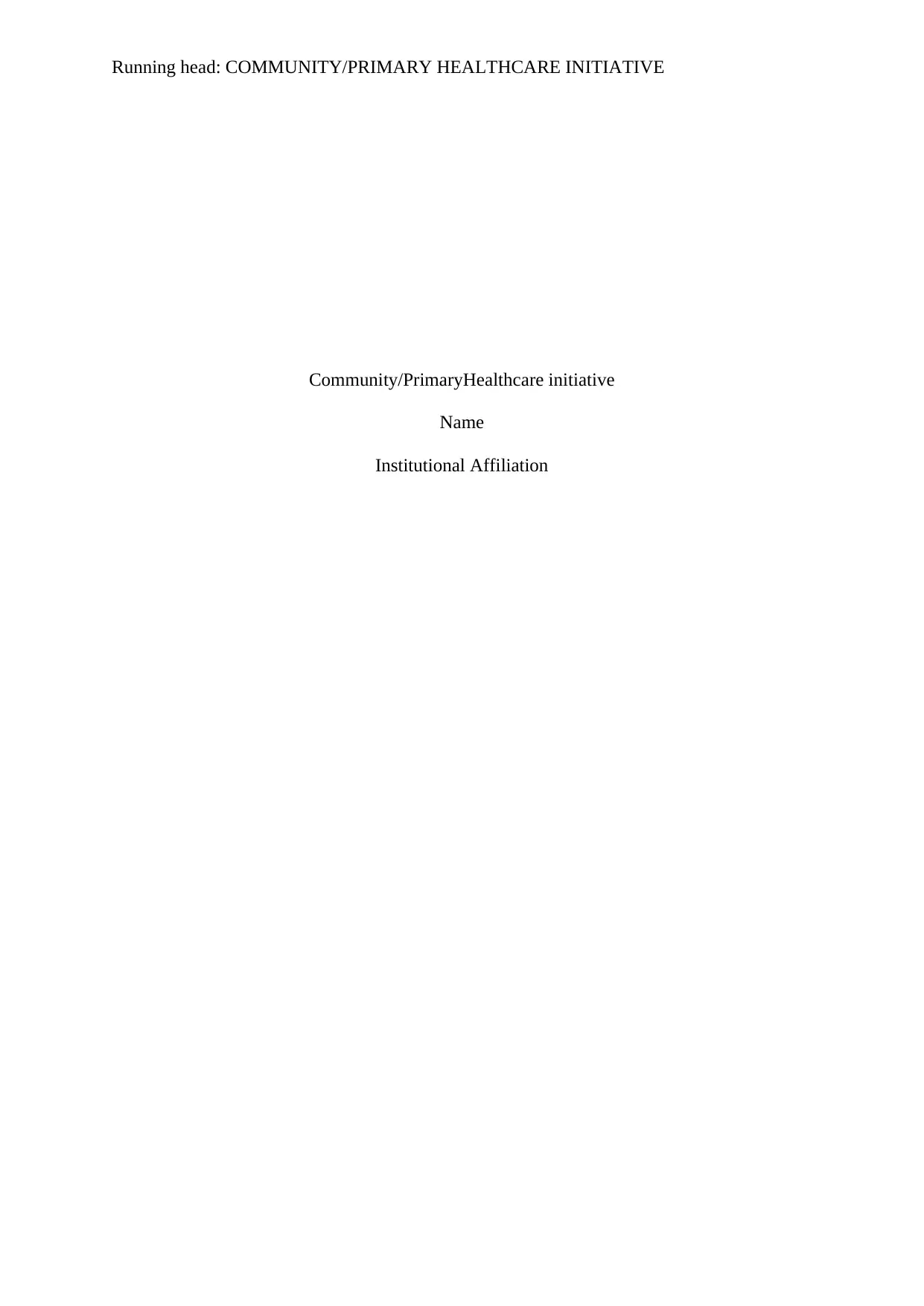
Running head: COMMUNITY/PRIMARY HEALTHCARE INITIATIVE
Community/PrimaryHealthcare initiative
Name
Institutional Affiliation
Community/PrimaryHealthcare initiative
Name
Institutional Affiliation
Paraphrase This Document
Need a fresh take? Get an instant paraphrase of this document with our AI Paraphraser
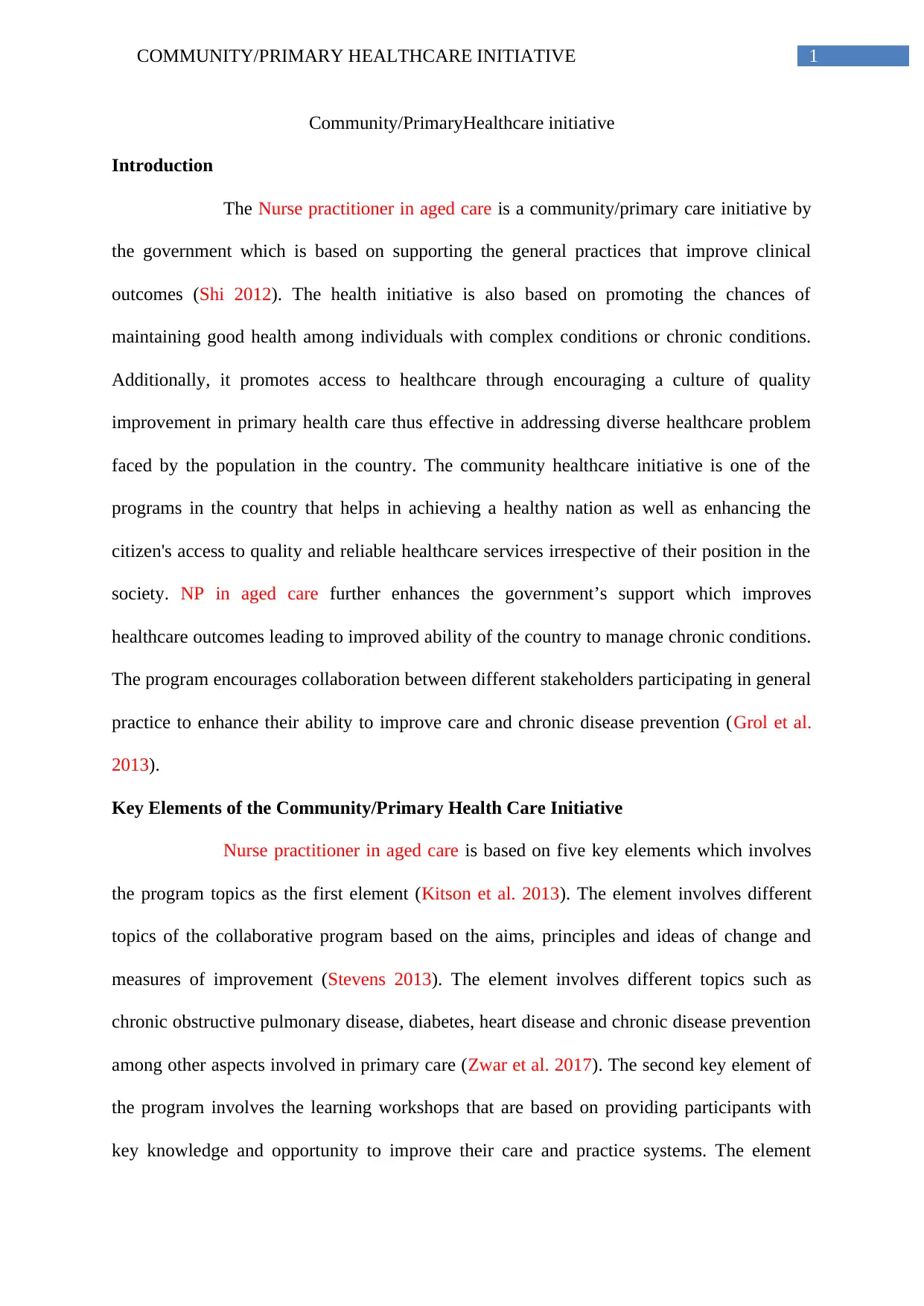
1COMMUNITY/PRIMARY HEALTHCARE INITIATIVE
Community/PrimaryHealthcare initiative
Introduction
The Nurse practitioner in aged care is a community/primary care initiative by
the government which is based on supporting the general practices that improve clinical
outcomes (Shi 2012). The health initiative is also based on promoting the chances of
maintaining good health among individuals with complex conditions or chronic conditions.
Additionally, it promotes access to healthcare through encouraging a culture of quality
improvement in primary health care thus effective in addressing diverse healthcare problem
faced by the population in the country. The community healthcare initiative is one of the
programs in the country that helps in achieving a healthy nation as well as enhancing the
citizen's access to quality and reliable healthcare services irrespective of their position in the
society. NP in aged care further enhances the government’s support which improves
healthcare outcomes leading to improved ability of the country to manage chronic conditions.
The program encourages collaboration between different stakeholders participating in general
practice to enhance their ability to improve care and chronic disease prevention (Grol et al.
2013).
Key Elements of the Community/Primary Health Care Initiative
Nurse practitioner in aged care is based on five key elements which involves
the program topics as the first element (Kitson et al. 2013). The element involves different
topics of the collaborative program based on the aims, principles and ideas of change and
measures of improvement (Stevens 2013). The element involves different topics such as
chronic obstructive pulmonary disease, diabetes, heart disease and chronic disease prevention
among other aspects involved in primary care (Zwar et al. 2017). The second key element of
the program involves the learning workshops that are based on providing participants with
key knowledge and opportunity to improve their care and practice systems. The element
Community/PrimaryHealthcare initiative
Introduction
The Nurse practitioner in aged care is a community/primary care initiative by
the government which is based on supporting the general practices that improve clinical
outcomes (Shi 2012). The health initiative is also based on promoting the chances of
maintaining good health among individuals with complex conditions or chronic conditions.
Additionally, it promotes access to healthcare through encouraging a culture of quality
improvement in primary health care thus effective in addressing diverse healthcare problem
faced by the population in the country. The community healthcare initiative is one of the
programs in the country that helps in achieving a healthy nation as well as enhancing the
citizen's access to quality and reliable healthcare services irrespective of their position in the
society. NP in aged care further enhances the government’s support which improves
healthcare outcomes leading to improved ability of the country to manage chronic conditions.
The program encourages collaboration between different stakeholders participating in general
practice to enhance their ability to improve care and chronic disease prevention (Grol et al.
2013).
Key Elements of the Community/Primary Health Care Initiative
Nurse practitioner in aged care is based on five key elements which involves
the program topics as the first element (Kitson et al. 2013). The element involves different
topics of the collaborative program based on the aims, principles and ideas of change and
measures of improvement (Stevens 2013). The element involves different topics such as
chronic obstructive pulmonary disease, diabetes, heart disease and chronic disease prevention
among other aspects involved in primary care (Zwar et al. 2017). The second key element of
the program involves the learning workshops that are based on providing participants with
key knowledge and opportunity to improve their care and practice systems. The element

2COMMUNITY/PRIMARY HEALTHCARE INITIATIVE
further exposes the primary care providers to ideas and experiences from different
professionals which play a significant role in improving their practice as well as promoting
positive outcomes. This serves as one of the major elements of the program since it provides
the basis for achieving its key objectives of improving the clinical outcomes and maintaining
good health among people with complex and chronic conditions.
The third key element of the NP in aged care program involves activity
periods with local support which is done between and after the learning workshops in order to
ensure the implementation of the improvement or new practices learned (Seymour et al.
2013). The element also introduces the aspect of local support for the healthcare practice
activities in order to achieve positive outcomes. The element plays a significant role in
achieving evidence-based practice; however, implementation is based on cycles of small
changes to ensure positive outcomes. Besides, the local support activity promotes the chances
of achieving the collaborative approach of the program by ensuring the community members
are involved in healthcare services. The element further promotes the chances of effectively
improving access to healthcare by promoting a culture of quality improvement in the delivery
of primary healthcare. The fourth key element of the program involves providing data reports
and feedback which helps in analysing the performance of the program. The element creates
the need to among primary healthcare providers to deliver monthly data through an online
reporting system which demonstrates the improvements within a given time. The last element
of the NP in aged care involves spread and sustainability which incorporates participating in
local groups that can help in spreading the knowledge on collaboration to general practices
(Walsh et al. 2012).
The five key elements of the Nurse practitioner in aged care program promote
the chances of achieving the desired objectives as well as enhancing quality improvement in
primary healthcare services (Stirman et al. 2012). The program has also been effective in
further exposes the primary care providers to ideas and experiences from different
professionals which play a significant role in improving their practice as well as promoting
positive outcomes. This serves as one of the major elements of the program since it provides
the basis for achieving its key objectives of improving the clinical outcomes and maintaining
good health among people with complex and chronic conditions.
The third key element of the NP in aged care program involves activity
periods with local support which is done between and after the learning workshops in order to
ensure the implementation of the improvement or new practices learned (Seymour et al.
2013). The element also introduces the aspect of local support for the healthcare practice
activities in order to achieve positive outcomes. The element plays a significant role in
achieving evidence-based practice; however, implementation is based on cycles of small
changes to ensure positive outcomes. Besides, the local support activity promotes the chances
of achieving the collaborative approach of the program by ensuring the community members
are involved in healthcare services. The element further promotes the chances of effectively
improving access to healthcare by promoting a culture of quality improvement in the delivery
of primary healthcare. The fourth key element of the program involves providing data reports
and feedback which helps in analysing the performance of the program. The element creates
the need to among primary healthcare providers to deliver monthly data through an online
reporting system which demonstrates the improvements within a given time. The last element
of the NP in aged care involves spread and sustainability which incorporates participating in
local groups that can help in spreading the knowledge on collaboration to general practices
(Walsh et al. 2012).
The five key elements of the Nurse practitioner in aged care program promote
the chances of achieving the desired objectives as well as enhancing quality improvement in
primary healthcare services (Stirman et al. 2012). The program has also been effective in
⊘ This is a preview!⊘
Do you want full access?
Subscribe today to unlock all pages.

Trusted by 1+ million students worldwide
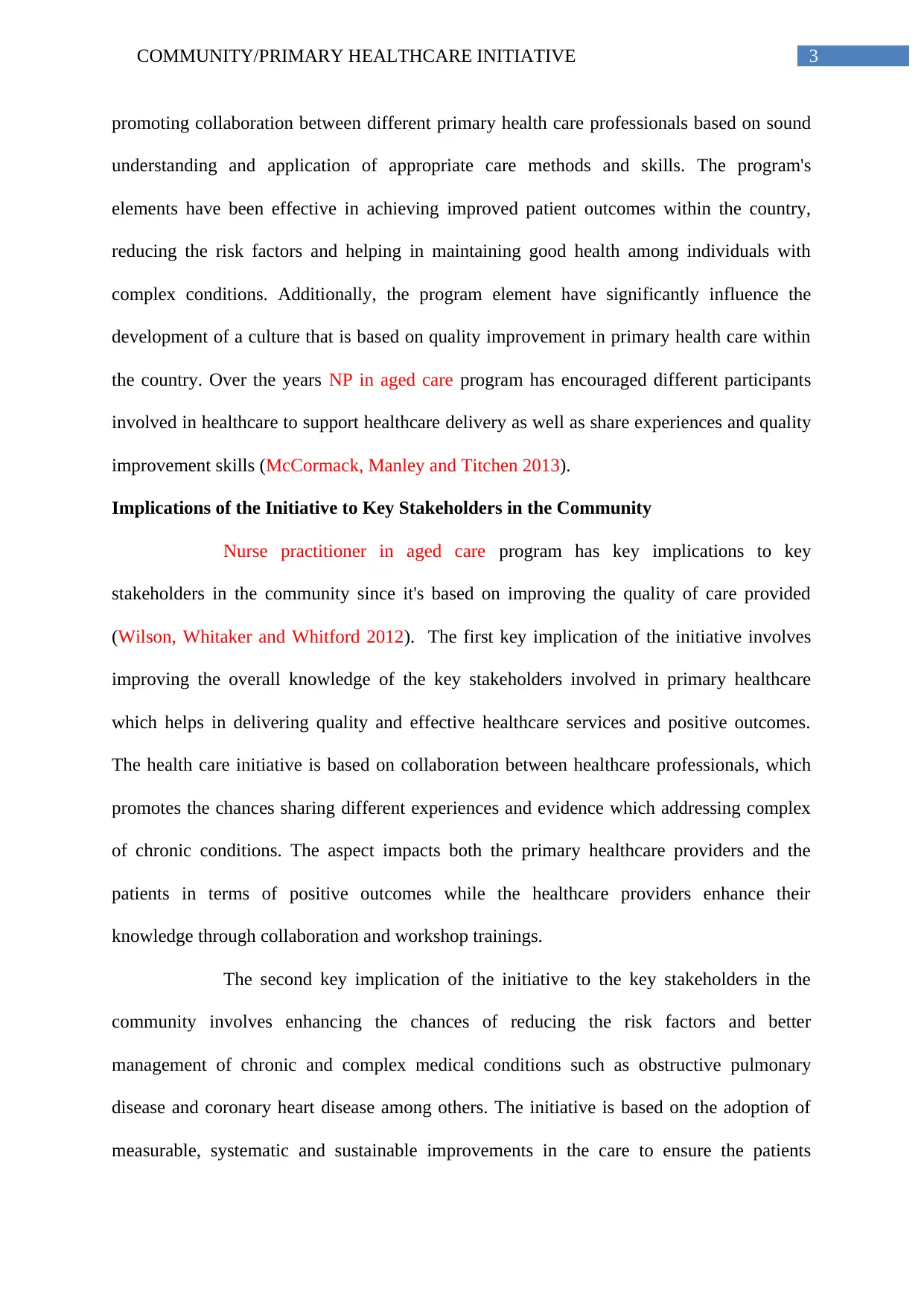
3COMMUNITY/PRIMARY HEALTHCARE INITIATIVE
promoting collaboration between different primary health care professionals based on sound
understanding and application of appropriate care methods and skills. The program's
elements have been effective in achieving improved patient outcomes within the country,
reducing the risk factors and helping in maintaining good health among individuals with
complex conditions. Additionally, the program element have significantly influence the
development of a culture that is based on quality improvement in primary health care within
the country. Over the years NP in aged care program has encouraged different participants
involved in healthcare to support healthcare delivery as well as share experiences and quality
improvement skills (McCormack, Manley and Titchen 2013).
Implications of the Initiative to Key Stakeholders in the Community
Nurse practitioner in aged care program has key implications to key
stakeholders in the community since it's based on improving the quality of care provided
(Wilson, Whitaker and Whitford 2012). The first key implication of the initiative involves
improving the overall knowledge of the key stakeholders involved in primary healthcare
which helps in delivering quality and effective healthcare services and positive outcomes.
The health care initiative is based on collaboration between healthcare professionals, which
promotes the chances sharing different experiences and evidence which addressing complex
of chronic conditions. The aspect impacts both the primary healthcare providers and the
patients in terms of positive outcomes while the healthcare providers enhance their
knowledge through collaboration and workshop trainings.
The second key implication of the initiative to the key stakeholders in the
community involves enhancing the chances of reducing the risk factors and better
management of chronic and complex medical conditions such as obstructive pulmonary
disease and coronary heart disease among others. The initiative is based on the adoption of
measurable, systematic and sustainable improvements in the care to ensure the patients
promoting collaboration between different primary health care professionals based on sound
understanding and application of appropriate care methods and skills. The program's
elements have been effective in achieving improved patient outcomes within the country,
reducing the risk factors and helping in maintaining good health among individuals with
complex conditions. Additionally, the program element have significantly influence the
development of a culture that is based on quality improvement in primary health care within
the country. Over the years NP in aged care program has encouraged different participants
involved in healthcare to support healthcare delivery as well as share experiences and quality
improvement skills (McCormack, Manley and Titchen 2013).
Implications of the Initiative to Key Stakeholders in the Community
Nurse practitioner in aged care program has key implications to key
stakeholders in the community since it's based on improving the quality of care provided
(Wilson, Whitaker and Whitford 2012). The first key implication of the initiative involves
improving the overall knowledge of the key stakeholders involved in primary healthcare
which helps in delivering quality and effective healthcare services and positive outcomes.
The health care initiative is based on collaboration between healthcare professionals, which
promotes the chances sharing different experiences and evidence which addressing complex
of chronic conditions. The aspect impacts both the primary healthcare providers and the
patients in terms of positive outcomes while the healthcare providers enhance their
knowledge through collaboration and workshop trainings.
The second key implication of the initiative to the key stakeholders in the
community involves enhancing the chances of reducing the risk factors and better
management of chronic and complex medical conditions such as obstructive pulmonary
disease and coronary heart disease among others. The initiative is based on the adoption of
measurable, systematic and sustainable improvements in the care to ensure the patients
Paraphrase This Document
Need a fresh take? Get an instant paraphrase of this document with our AI Paraphraser
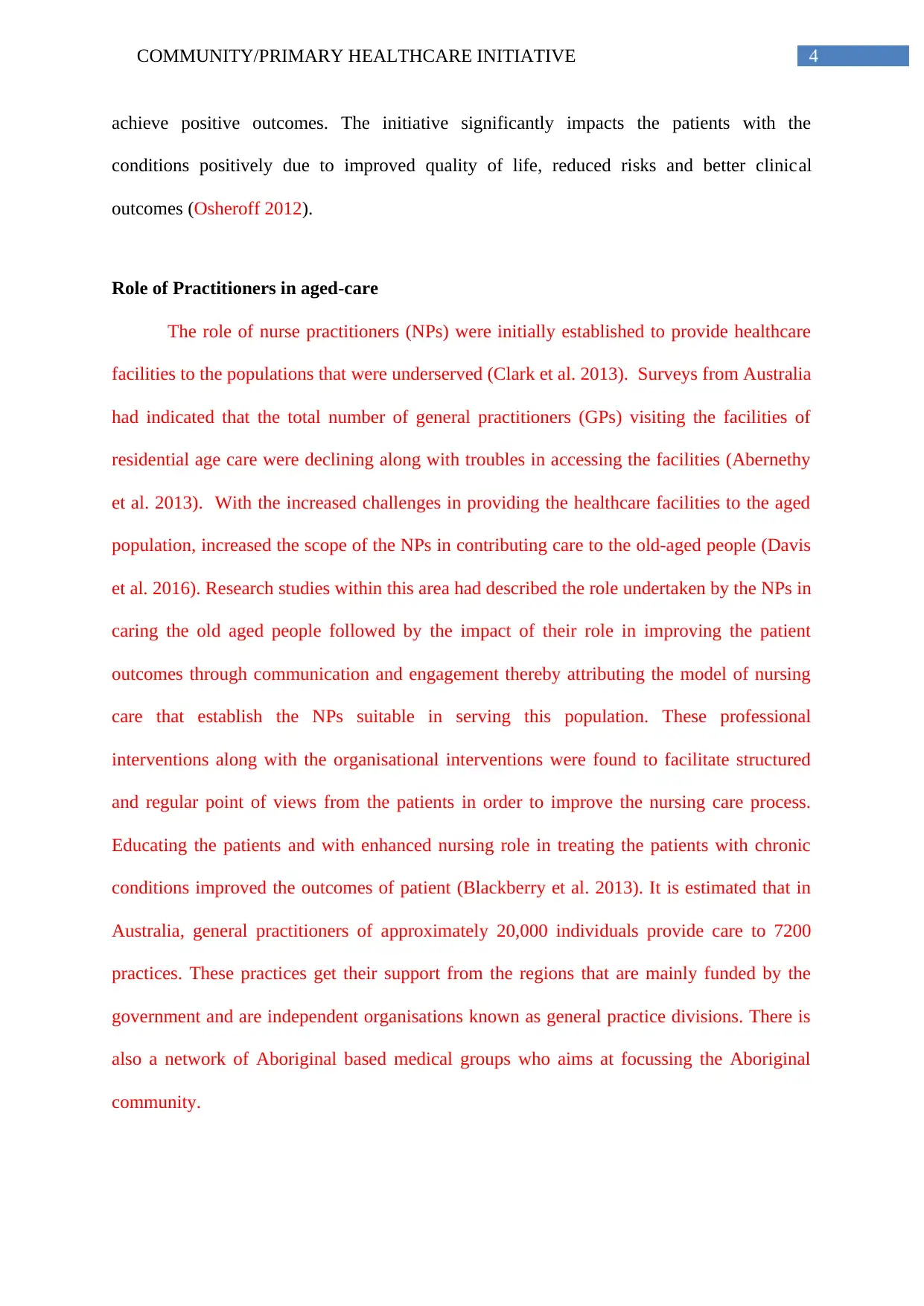
4COMMUNITY/PRIMARY HEALTHCARE INITIATIVE
achieve positive outcomes. The initiative significantly impacts the patients with the
conditions positively due to improved quality of life, reduced risks and better clinical
outcomes (Osheroff 2012).
Role of Practitioners in aged-care
The role of nurse practitioners (NPs) were initially established to provide healthcare
facilities to the populations that were underserved (Clark et al. 2013). Surveys from Australia
had indicated that the total number of general practitioners (GPs) visiting the facilities of
residential age care were declining along with troubles in accessing the facilities (Abernethy
et al. 2013). With the increased challenges in providing the healthcare facilities to the aged
population, increased the scope of the NPs in contributing care to the old-aged people (Davis
et al. 2016). Research studies within this area had described the role undertaken by the NPs in
caring the old aged people followed by the impact of their role in improving the patient
outcomes through communication and engagement thereby attributing the model of nursing
care that establish the NPs suitable in serving this population. These professional
interventions along with the organisational interventions were found to facilitate structured
and regular point of views from the patients in order to improve the nursing care process.
Educating the patients and with enhanced nursing role in treating the patients with chronic
conditions improved the outcomes of patient (Blackberry et al. 2013). It is estimated that in
Australia, general practitioners of approximately 20,000 individuals provide care to 7200
practices. These practices get their support from the regions that are mainly funded by the
government and are independent organisations known as general practice divisions. There is
also a network of Aboriginal based medical groups who aims at focussing the Aboriginal
community.
achieve positive outcomes. The initiative significantly impacts the patients with the
conditions positively due to improved quality of life, reduced risks and better clinical
outcomes (Osheroff 2012).
Role of Practitioners in aged-care
The role of nurse practitioners (NPs) were initially established to provide healthcare
facilities to the populations that were underserved (Clark et al. 2013). Surveys from Australia
had indicated that the total number of general practitioners (GPs) visiting the facilities of
residential age care were declining along with troubles in accessing the facilities (Abernethy
et al. 2013). With the increased challenges in providing the healthcare facilities to the aged
population, increased the scope of the NPs in contributing care to the old-aged people (Davis
et al. 2016). Research studies within this area had described the role undertaken by the NPs in
caring the old aged people followed by the impact of their role in improving the patient
outcomes through communication and engagement thereby attributing the model of nursing
care that establish the NPs suitable in serving this population. These professional
interventions along with the organisational interventions were found to facilitate structured
and regular point of views from the patients in order to improve the nursing care process.
Educating the patients and with enhanced nursing role in treating the patients with chronic
conditions improved the outcomes of patient (Blackberry et al. 2013). It is estimated that in
Australia, general practitioners of approximately 20,000 individuals provide care to 7200
practices. These practices get their support from the regions that are mainly funded by the
government and are independent organisations known as general practice divisions. There is
also a network of Aboriginal based medical groups who aims at focussing the Aboriginal
community.
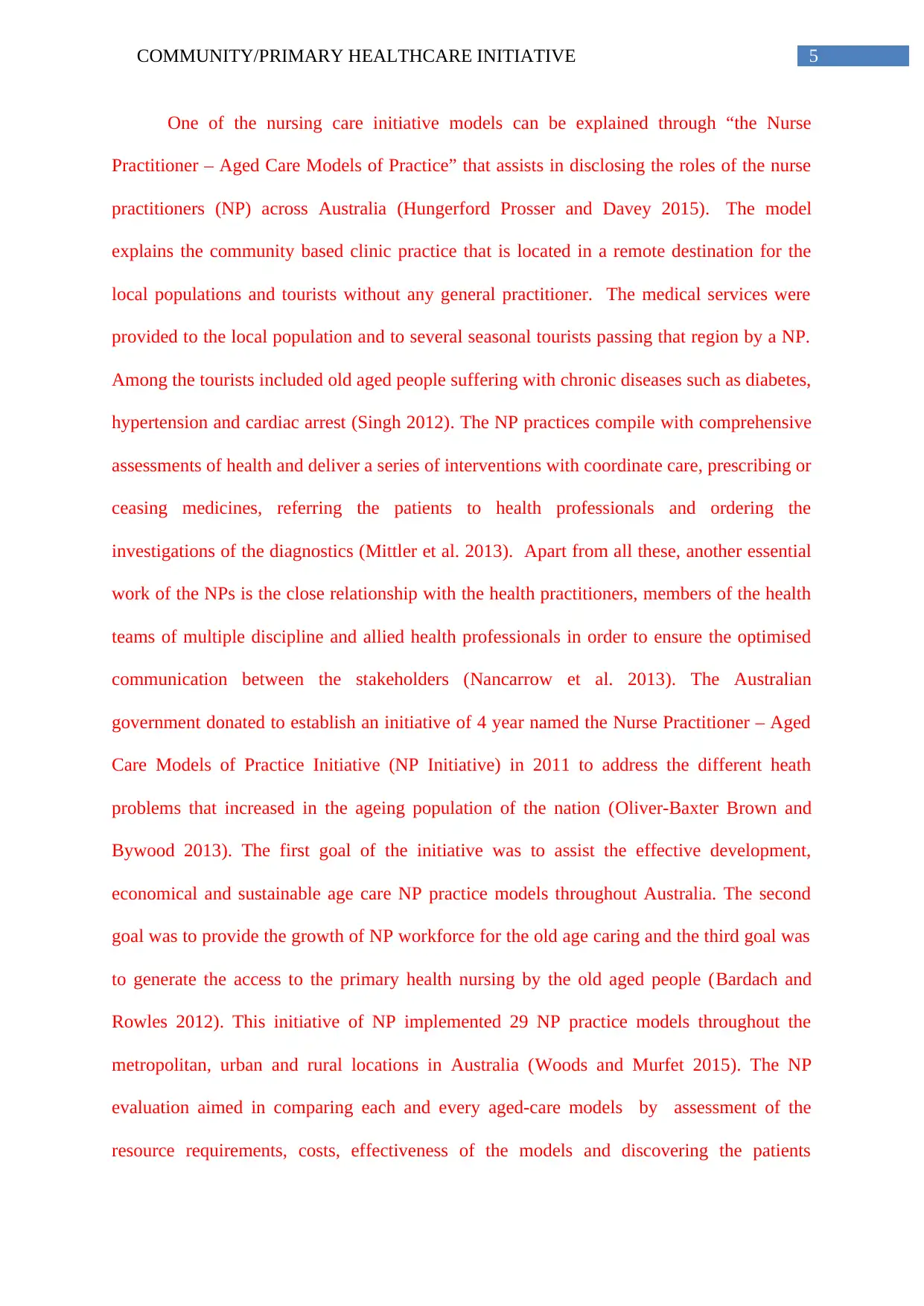
5COMMUNITY/PRIMARY HEALTHCARE INITIATIVE
One of the nursing care initiative models can be explained through “the Nurse
Practitioner – Aged Care Models of Practice” that assists in disclosing the roles of the nurse
practitioners (NP) across Australia (Hungerford Prosser and Davey 2015). The model
explains the community based clinic practice that is located in a remote destination for the
local populations and tourists without any general practitioner. The medical services were
provided to the local population and to several seasonal tourists passing that region by a NP.
Among the tourists included old aged people suffering with chronic diseases such as diabetes,
hypertension and cardiac arrest (Singh 2012). The NP practices compile with comprehensive
assessments of health and deliver a series of interventions with coordinate care, prescribing or
ceasing medicines, referring the patients to health professionals and ordering the
investigations of the diagnostics (Mittler et al. 2013). Apart from all these, another essential
work of the NPs is the close relationship with the health practitioners, members of the health
teams of multiple discipline and allied health professionals in order to ensure the optimised
communication between the stakeholders (Nancarrow et al. 2013). The Australian
government donated to establish an initiative of 4 year named the Nurse Practitioner – Aged
Care Models of Practice Initiative (NP Initiative) in 2011 to address the different heath
problems that increased in the ageing population of the nation (Oliver-Baxter Brown and
Bywood 2013). The first goal of the initiative was to assist the effective development,
economical and sustainable age care NP practice models throughout Australia. The second
goal was to provide the growth of NP workforce for the old age caring and the third goal was
to generate the access to the primary health nursing by the old aged people (Bardach and
Rowles 2012). This initiative of NP implemented 29 NP practice models throughout the
metropolitan, urban and rural locations in Australia (Woods and Murfet 2015). The NP
evaluation aimed in comparing each and every aged-care models by assessment of the
resource requirements, costs, effectiveness of the models and discovering the patients
One of the nursing care initiative models can be explained through “the Nurse
Practitioner – Aged Care Models of Practice” that assists in disclosing the roles of the nurse
practitioners (NP) across Australia (Hungerford Prosser and Davey 2015). The model
explains the community based clinic practice that is located in a remote destination for the
local populations and tourists without any general practitioner. The medical services were
provided to the local population and to several seasonal tourists passing that region by a NP.
Among the tourists included old aged people suffering with chronic diseases such as diabetes,
hypertension and cardiac arrest (Singh 2012). The NP practices compile with comprehensive
assessments of health and deliver a series of interventions with coordinate care, prescribing or
ceasing medicines, referring the patients to health professionals and ordering the
investigations of the diagnostics (Mittler et al. 2013). Apart from all these, another essential
work of the NPs is the close relationship with the health practitioners, members of the health
teams of multiple discipline and allied health professionals in order to ensure the optimised
communication between the stakeholders (Nancarrow et al. 2013). The Australian
government donated to establish an initiative of 4 year named the Nurse Practitioner – Aged
Care Models of Practice Initiative (NP Initiative) in 2011 to address the different heath
problems that increased in the ageing population of the nation (Oliver-Baxter Brown and
Bywood 2013). The first goal of the initiative was to assist the effective development,
economical and sustainable age care NP practice models throughout Australia. The second
goal was to provide the growth of NP workforce for the old age caring and the third goal was
to generate the access to the primary health nursing by the old aged people (Bardach and
Rowles 2012). This initiative of NP implemented 29 NP practice models throughout the
metropolitan, urban and rural locations in Australia (Woods and Murfet 2015). The NP
evaluation aimed in comparing each and every aged-care models by assessment of the
resource requirements, costs, effectiveness of the models and discovering the patients
⊘ This is a preview!⊘
Do you want full access?
Subscribe today to unlock all pages.

Trusted by 1+ million students worldwide
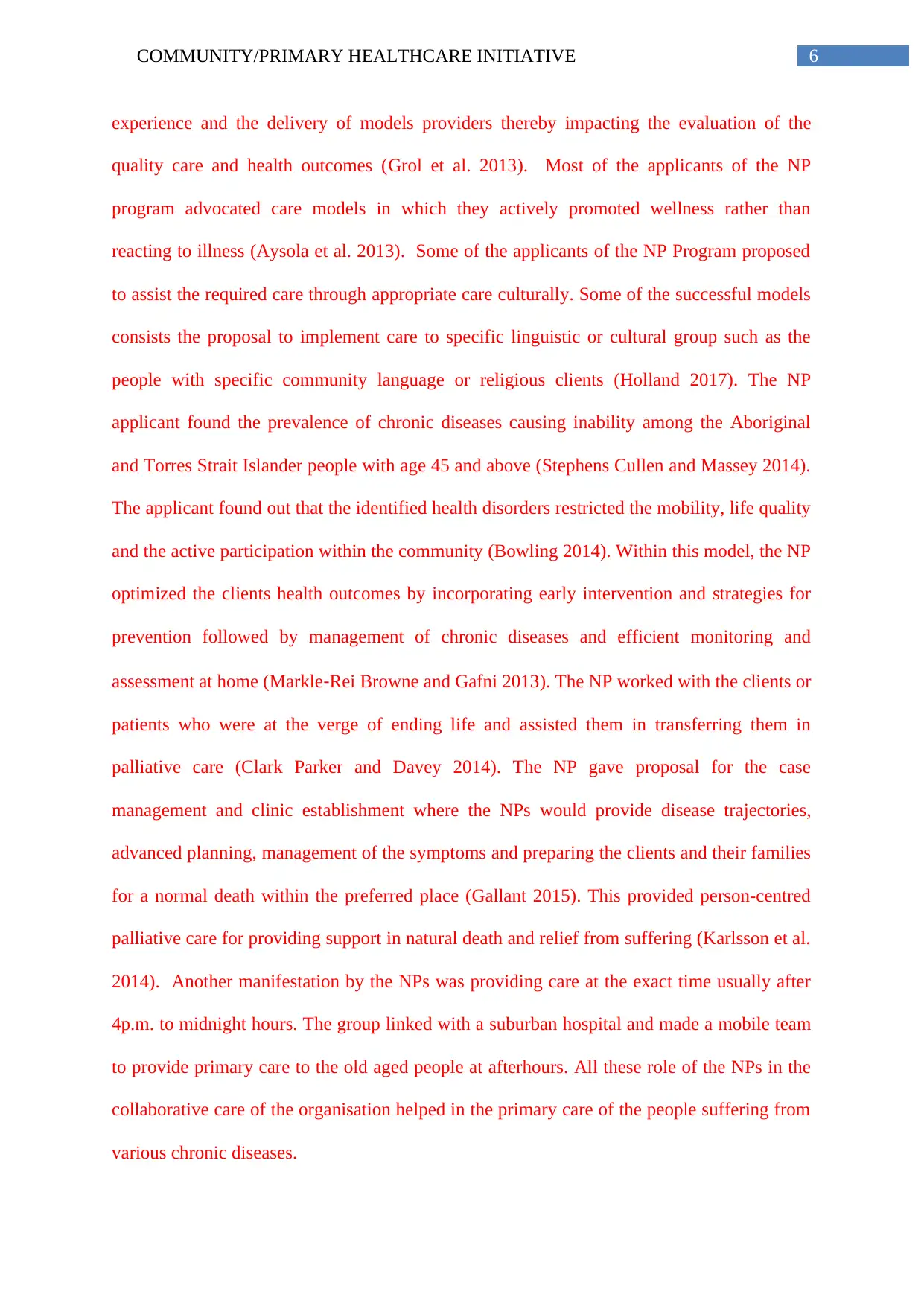
6COMMUNITY/PRIMARY HEALTHCARE INITIATIVE
experience and the delivery of models providers thereby impacting the evaluation of the
quality care and health outcomes (Grol et al. 2013). Most of the applicants of the NP
program advocated care models in which they actively promoted wellness rather than
reacting to illness (Aysola et al. 2013). Some of the applicants of the NP Program proposed
to assist the required care through appropriate care culturally. Some of the successful models
consists the proposal to implement care to specific linguistic or cultural group such as the
people with specific community language or religious clients (Holland 2017). The NP
applicant found the prevalence of chronic diseases causing inability among the Aboriginal
and Torres Strait Islander people with age 45 and above (Stephens Cullen and Massey 2014).
The applicant found out that the identified health disorders restricted the mobility, life quality
and the active participation within the community (Bowling 2014). Within this model, the NP
optimized the clients health outcomes by incorporating early intervention and strategies for
prevention followed by management of chronic diseases and efficient monitoring and
assessment at home (Markle‐Rei Browne and Gafni 2013). The NP worked with the clients or
patients who were at the verge of ending life and assisted them in transferring them in
palliative care (Clark Parker and Davey 2014). The NP gave proposal for the case
management and clinic establishment where the NPs would provide disease trajectories,
advanced planning, management of the symptoms and preparing the clients and their families
for a normal death within the preferred place (Gallant 2015). This provided person-centred
palliative care for providing support in natural death and relief from suffering (Karlsson et al.
2014). Another manifestation by the NPs was providing care at the exact time usually after
4p.m. to midnight hours. The group linked with a suburban hospital and made a mobile team
to provide primary care to the old aged people at afterhours. All these role of the NPs in the
collaborative care of the organisation helped in the primary care of the people suffering from
various chronic diseases.
experience and the delivery of models providers thereby impacting the evaluation of the
quality care and health outcomes (Grol et al. 2013). Most of the applicants of the NP
program advocated care models in which they actively promoted wellness rather than
reacting to illness (Aysola et al. 2013). Some of the applicants of the NP Program proposed
to assist the required care through appropriate care culturally. Some of the successful models
consists the proposal to implement care to specific linguistic or cultural group such as the
people with specific community language or religious clients (Holland 2017). The NP
applicant found the prevalence of chronic diseases causing inability among the Aboriginal
and Torres Strait Islander people with age 45 and above (Stephens Cullen and Massey 2014).
The applicant found out that the identified health disorders restricted the mobility, life quality
and the active participation within the community (Bowling 2014). Within this model, the NP
optimized the clients health outcomes by incorporating early intervention and strategies for
prevention followed by management of chronic diseases and efficient monitoring and
assessment at home (Markle‐Rei Browne and Gafni 2013). The NP worked with the clients or
patients who were at the verge of ending life and assisted them in transferring them in
palliative care (Clark Parker and Davey 2014). The NP gave proposal for the case
management and clinic establishment where the NPs would provide disease trajectories,
advanced planning, management of the symptoms and preparing the clients and their families
for a normal death within the preferred place (Gallant 2015). This provided person-centred
palliative care for providing support in natural death and relief from suffering (Karlsson et al.
2014). Another manifestation by the NPs was providing care at the exact time usually after
4p.m. to midnight hours. The group linked with a suburban hospital and made a mobile team
to provide primary care to the old aged people at afterhours. All these role of the NPs in the
collaborative care of the organisation helped in the primary care of the people suffering from
various chronic diseases.
Paraphrase This Document
Need a fresh take? Get an instant paraphrase of this document with our AI Paraphraser
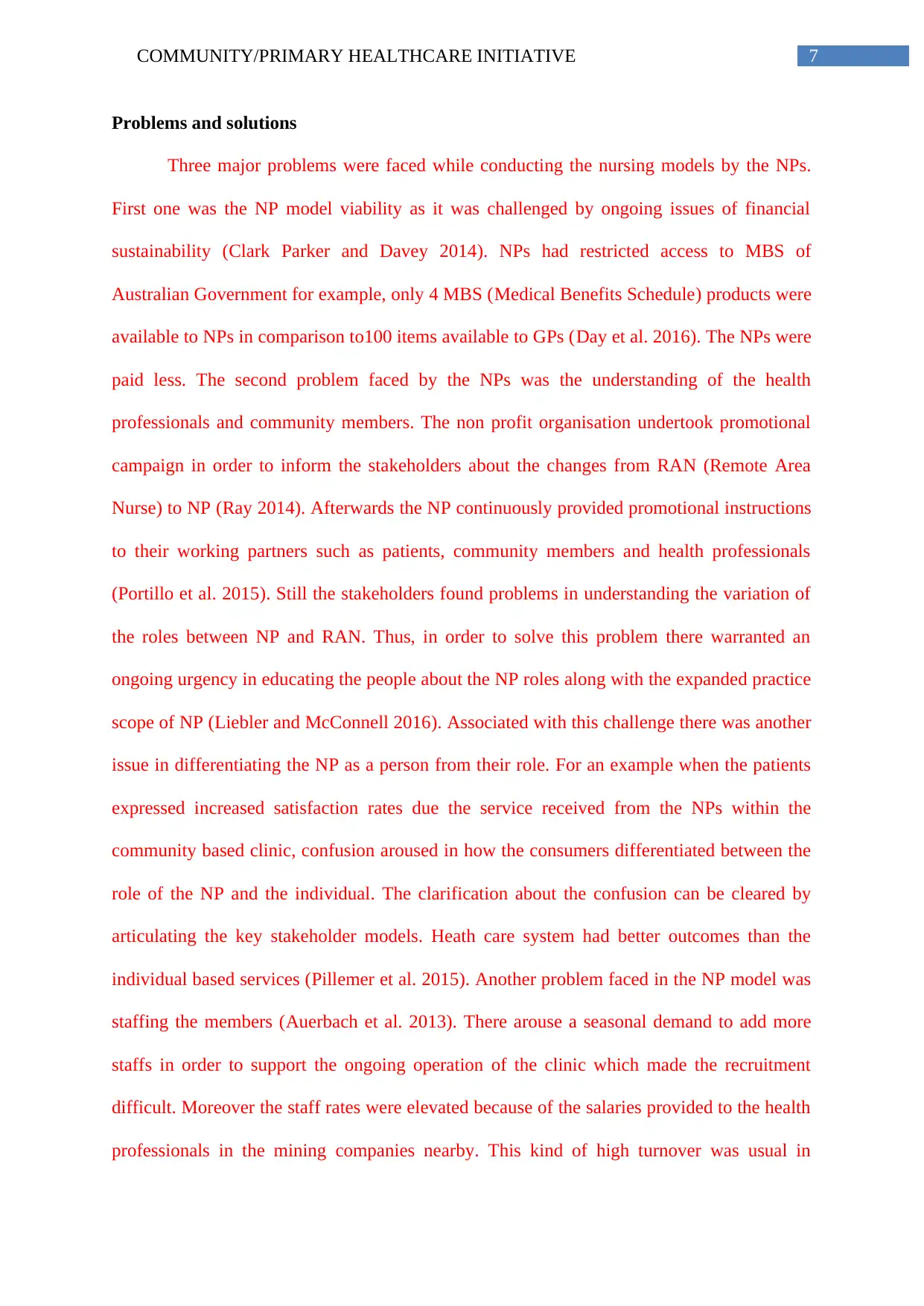
7COMMUNITY/PRIMARY HEALTHCARE INITIATIVE
Problems and solutions
Three major problems were faced while conducting the nursing models by the NPs.
First one was the NP model viability as it was challenged by ongoing issues of financial
sustainability (Clark Parker and Davey 2014). NPs had restricted access to MBS of
Australian Government for example, only 4 MBS (Medical Benefits Schedule) products were
available to NPs in comparison to100 items available to GPs (Day et al. 2016). The NPs were
paid less. The second problem faced by the NPs was the understanding of the health
professionals and community members. The non profit organisation undertook promotional
campaign in order to inform the stakeholders about the changes from RAN (Remote Area
Nurse) to NP (Ray 2014). Afterwards the NP continuously provided promotional instructions
to their working partners such as patients, community members and health professionals
(Portillo et al. 2015). Still the stakeholders found problems in understanding the variation of
the roles between NP and RAN. Thus, in order to solve this problem there warranted an
ongoing urgency in educating the people about the NP roles along with the expanded practice
scope of NP (Liebler and McConnell 2016). Associated with this challenge there was another
issue in differentiating the NP as a person from their role. For an example when the patients
expressed increased satisfaction rates due the service received from the NPs within the
community based clinic, confusion aroused in how the consumers differentiated between the
role of the NP and the individual. The clarification about the confusion can be cleared by
articulating the key stakeholder models. Heath care system had better outcomes than the
individual based services (Pillemer et al. 2015). Another problem faced in the NP model was
staffing the members (Auerbach et al. 2013). There arouse a seasonal demand to add more
staffs in order to support the ongoing operation of the clinic which made the recruitment
difficult. Moreover the staff rates were elevated because of the salaries provided to the health
professionals in the mining companies nearby. This kind of high turnover was usual in
Problems and solutions
Three major problems were faced while conducting the nursing models by the NPs.
First one was the NP model viability as it was challenged by ongoing issues of financial
sustainability (Clark Parker and Davey 2014). NPs had restricted access to MBS of
Australian Government for example, only 4 MBS (Medical Benefits Schedule) products were
available to NPs in comparison to100 items available to GPs (Day et al. 2016). The NPs were
paid less. The second problem faced by the NPs was the understanding of the health
professionals and community members. The non profit organisation undertook promotional
campaign in order to inform the stakeholders about the changes from RAN (Remote Area
Nurse) to NP (Ray 2014). Afterwards the NP continuously provided promotional instructions
to their working partners such as patients, community members and health professionals
(Portillo et al. 2015). Still the stakeholders found problems in understanding the variation of
the roles between NP and RAN. Thus, in order to solve this problem there warranted an
ongoing urgency in educating the people about the NP roles along with the expanded practice
scope of NP (Liebler and McConnell 2016). Associated with this challenge there was another
issue in differentiating the NP as a person from their role. For an example when the patients
expressed increased satisfaction rates due the service received from the NPs within the
community based clinic, confusion aroused in how the consumers differentiated between the
role of the NP and the individual. The clarification about the confusion can be cleared by
articulating the key stakeholder models. Heath care system had better outcomes than the
individual based services (Pillemer et al. 2015). Another problem faced in the NP model was
staffing the members (Auerbach et al. 2013). There arouse a seasonal demand to add more
staffs in order to support the ongoing operation of the clinic which made the recruitment
difficult. Moreover the staff rates were elevated because of the salaries provided to the health
professionals in the mining companies nearby. This kind of high turnover was usual in
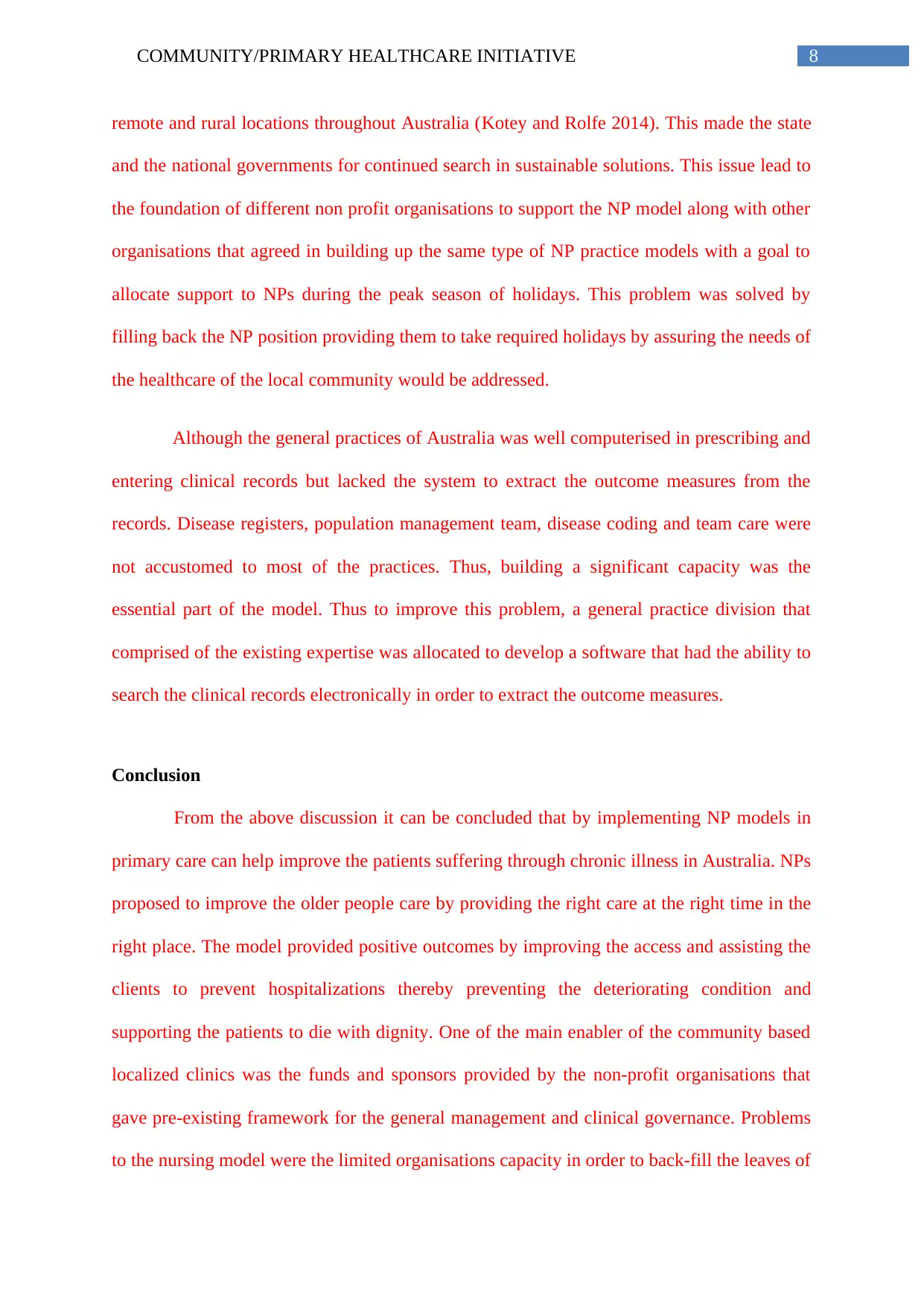
8COMMUNITY/PRIMARY HEALTHCARE INITIATIVE
remote and rural locations throughout Australia (Kotey and Rolfe 2014). This made the state
and the national governments for continued search in sustainable solutions. This issue lead to
the foundation of different non profit organisations to support the NP model along with other
organisations that agreed in building up the same type of NP practice models with a goal to
allocate support to NPs during the peak season of holidays. This problem was solved by
filling back the NP position providing them to take required holidays by assuring the needs of
the healthcare of the local community would be addressed.
Although the general practices of Australia was well computerised in prescribing and
entering clinical records but lacked the system to extract the outcome measures from the
records. Disease registers, population management team, disease coding and team care were
not accustomed to most of the practices. Thus, building a significant capacity was the
essential part of the model. Thus to improve this problem, a general practice division that
comprised of the existing expertise was allocated to develop a software that had the ability to
search the clinical records electronically in order to extract the outcome measures.
Conclusion
From the above discussion it can be concluded that by implementing NP models in
primary care can help improve the patients suffering through chronic illness in Australia. NPs
proposed to improve the older people care by providing the right care at the right time in the
right place. The model provided positive outcomes by improving the access and assisting the
clients to prevent hospitalizations thereby preventing the deteriorating condition and
supporting the patients to die with dignity. One of the main enabler of the community based
localized clinics was the funds and sponsors provided by the non-profit organisations that
gave pre-existing framework for the general management and clinical governance. Problems
to the nursing model were the limited organisations capacity in order to back-fill the leaves of
remote and rural locations throughout Australia (Kotey and Rolfe 2014). This made the state
and the national governments for continued search in sustainable solutions. This issue lead to
the foundation of different non profit organisations to support the NP model along with other
organisations that agreed in building up the same type of NP practice models with a goal to
allocate support to NPs during the peak season of holidays. This problem was solved by
filling back the NP position providing them to take required holidays by assuring the needs of
the healthcare of the local community would be addressed.
Although the general practices of Australia was well computerised in prescribing and
entering clinical records but lacked the system to extract the outcome measures from the
records. Disease registers, population management team, disease coding and team care were
not accustomed to most of the practices. Thus, building a significant capacity was the
essential part of the model. Thus to improve this problem, a general practice division that
comprised of the existing expertise was allocated to develop a software that had the ability to
search the clinical records electronically in order to extract the outcome measures.
Conclusion
From the above discussion it can be concluded that by implementing NP models in
primary care can help improve the patients suffering through chronic illness in Australia. NPs
proposed to improve the older people care by providing the right care at the right time in the
right place. The model provided positive outcomes by improving the access and assisting the
clients to prevent hospitalizations thereby preventing the deteriorating condition and
supporting the patients to die with dignity. One of the main enabler of the community based
localized clinics was the funds and sponsors provided by the non-profit organisations that
gave pre-existing framework for the general management and clinical governance. Problems
to the nursing model were the limited organisations capacity in order to back-fill the leaves of
⊘ This is a preview!⊘
Do you want full access?
Subscribe today to unlock all pages.

Trusted by 1+ million students worldwide
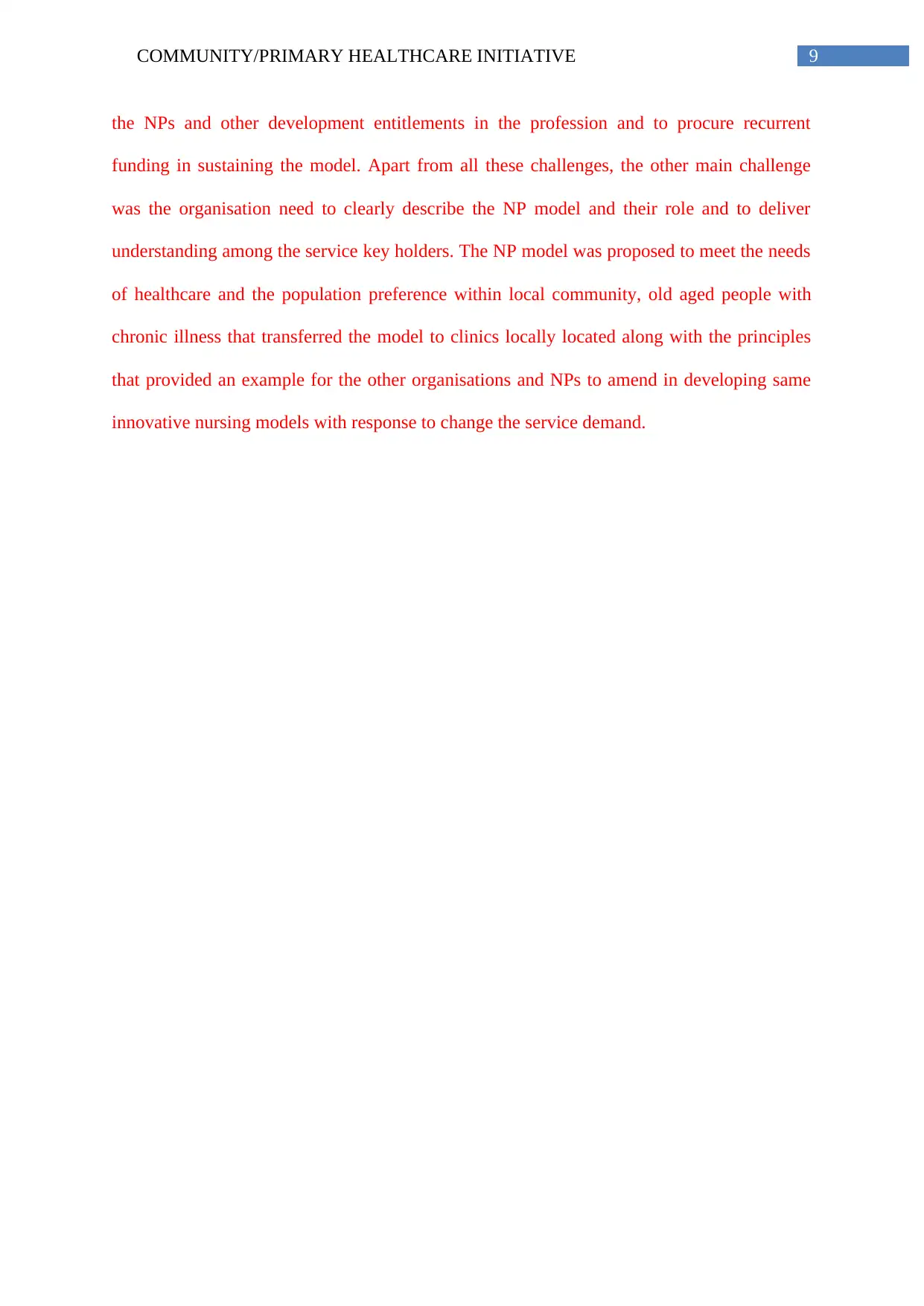
9COMMUNITY/PRIMARY HEALTHCARE INITIATIVE
the NPs and other development entitlements in the profession and to procure recurrent
funding in sustaining the model. Apart from all these challenges, the other main challenge
was the organisation need to clearly describe the NP model and their role and to deliver
understanding among the service key holders. The NP model was proposed to meet the needs
of healthcare and the population preference within local community, old aged people with
chronic illness that transferred the model to clinics locally located along with the principles
that provided an example for the other organisations and NPs to amend in developing same
innovative nursing models with response to change the service demand.
the NPs and other development entitlements in the profession and to procure recurrent
funding in sustaining the model. Apart from all these challenges, the other main challenge
was the organisation need to clearly describe the NP model and their role and to deliver
understanding among the service key holders. The NP model was proposed to meet the needs
of healthcare and the population preference within local community, old aged people with
chronic illness that transferred the model to clinics locally located along with the principles
that provided an example for the other organisations and NPs to amend in developing same
innovative nursing models with response to change the service demand.
Paraphrase This Document
Need a fresh take? Get an instant paraphrase of this document with our AI Paraphraser

10COMMUNITY/PRIMARY HEALTHCARE INITIATIVE
References
Abernethy, A.P., Currow, D.C., Shelby-James, T., Rowett, D., May, F., Samsa, G.P., Hunt,
R., Williams, H., Esterman, A. and Phillips, P.A., 2013. Delivery strategies to optimize
resource utilization and performance status for patients with advanced life-limiting illness:
results from the “palliative care trial” [ISRCTN 81117481]. Journal of pain and symptom
management, 45(3), pp.488-505.
Auerbach, D.I., Chen, P.G., Friedberg, M.W., Reid, R., Lau, C., Buerhaus, P.I. and Mehrotra,
A., 2013. Nurse-managed health centers and patient-centered medical homes could mitigate
expected primary care physician shortage. Health Affairs, 32(11), pp.1933-1941.
Aysola, J., Bitton, A., Zaslavsky, A.M. and Ayanian, J.Z., 2013. Quality and equity of
primary care with patient-centered medical homes: results from a national survey. Medical
care, 51(1), p.68.
Bardach, S.H. and Rowles, G.D., 2012. Geriatric education in the health professions: Are we
making progress?. The Gerontologist, 52(5), pp.607-618.
Blackberry, I.D., Furler, J.S., Best, J.D., Chondros, P., Vale, M., Walker, C., Dunning, T.,
Segal, L., Dunbar, J., Audehm, R. and Liew, D., 2013. Effectiveness of general practice
based, practice nurse led telephone coaching on glycaemic control of type 2 diabetes: the
Patient Engagement And Coaching for Health (PEACH) pragmatic cluster randomised
controlled trial. BMJ, 347, p.f5272.
Bowling, A., 2014. Research methods in health: investigating health and health services.
McGraw-Hill Education (UK).
References
Abernethy, A.P., Currow, D.C., Shelby-James, T., Rowett, D., May, F., Samsa, G.P., Hunt,
R., Williams, H., Esterman, A. and Phillips, P.A., 2013. Delivery strategies to optimize
resource utilization and performance status for patients with advanced life-limiting illness:
results from the “palliative care trial” [ISRCTN 81117481]. Journal of pain and symptom
management, 45(3), pp.488-505.
Auerbach, D.I., Chen, P.G., Friedberg, M.W., Reid, R., Lau, C., Buerhaus, P.I. and Mehrotra,
A., 2013. Nurse-managed health centers and patient-centered medical homes could mitigate
expected primary care physician shortage. Health Affairs, 32(11), pp.1933-1941.
Aysola, J., Bitton, A., Zaslavsky, A.M. and Ayanian, J.Z., 2013. Quality and equity of
primary care with patient-centered medical homes: results from a national survey. Medical
care, 51(1), p.68.
Bardach, S.H. and Rowles, G.D., 2012. Geriatric education in the health professions: Are we
making progress?. The Gerontologist, 52(5), pp.607-618.
Blackberry, I.D., Furler, J.S., Best, J.D., Chondros, P., Vale, M., Walker, C., Dunning, T.,
Segal, L., Dunbar, J., Audehm, R. and Liew, D., 2013. Effectiveness of general practice
based, practice nurse led telephone coaching on glycaemic control of type 2 diabetes: the
Patient Engagement And Coaching for Health (PEACH) pragmatic cluster randomised
controlled trial. BMJ, 347, p.f5272.
Bowling, A., 2014. Research methods in health: investigating health and health services.
McGraw-Hill Education (UK).
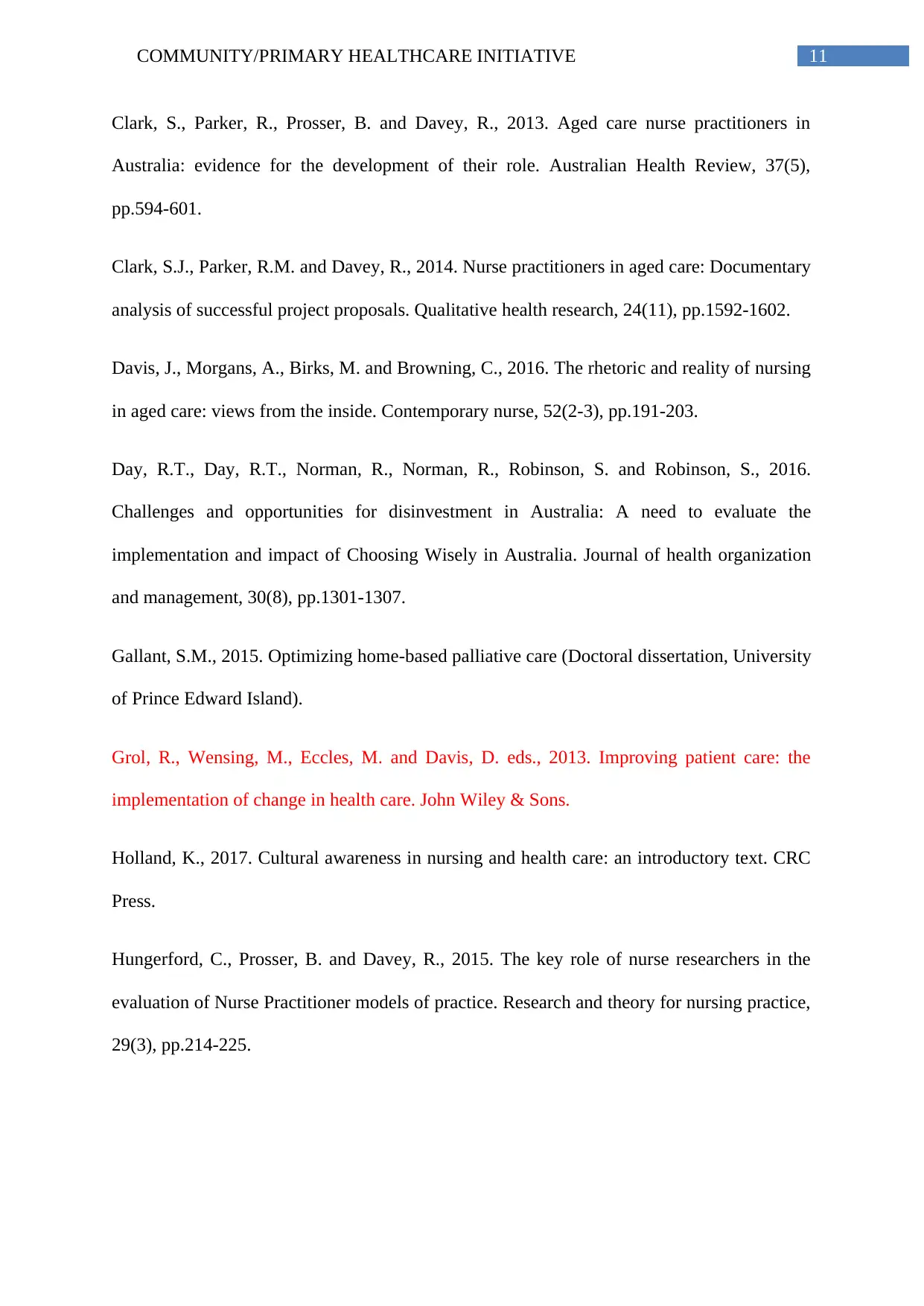
11COMMUNITY/PRIMARY HEALTHCARE INITIATIVE
Clark, S., Parker, R., Prosser, B. and Davey, R., 2013. Aged care nurse practitioners in
Australia: evidence for the development of their role. Australian Health Review, 37(5),
pp.594-601.
Clark, S.J., Parker, R.M. and Davey, R., 2014. Nurse practitioners in aged care: Documentary
analysis of successful project proposals. Qualitative health research, 24(11), pp.1592-1602.
Davis, J., Morgans, A., Birks, M. and Browning, C., 2016. The rhetoric and reality of nursing
in aged care: views from the inside. Contemporary nurse, 52(2-3), pp.191-203.
Day, R.T., Day, R.T., Norman, R., Norman, R., Robinson, S. and Robinson, S., 2016.
Challenges and opportunities for disinvestment in Australia: A need to evaluate the
implementation and impact of Choosing Wisely in Australia. Journal of health organization
and management, 30(8), pp.1301-1307.
Gallant, S.M., 2015. Optimizing home-based palliative care (Doctoral dissertation, University
of Prince Edward Island).
Grol, R., Wensing, M., Eccles, M. and Davis, D. eds., 2013. Improving patient care: the
implementation of change in health care. John Wiley & Sons.
Holland, K., 2017. Cultural awareness in nursing and health care: an introductory text. CRC
Press.
Hungerford, C., Prosser, B. and Davey, R., 2015. The key role of nurse researchers in the
evaluation of Nurse Practitioner models of practice. Research and theory for nursing practice,
29(3), pp.214-225.
Clark, S., Parker, R., Prosser, B. and Davey, R., 2013. Aged care nurse practitioners in
Australia: evidence for the development of their role. Australian Health Review, 37(5),
pp.594-601.
Clark, S.J., Parker, R.M. and Davey, R., 2014. Nurse practitioners in aged care: Documentary
analysis of successful project proposals. Qualitative health research, 24(11), pp.1592-1602.
Davis, J., Morgans, A., Birks, M. and Browning, C., 2016. The rhetoric and reality of nursing
in aged care: views from the inside. Contemporary nurse, 52(2-3), pp.191-203.
Day, R.T., Day, R.T., Norman, R., Norman, R., Robinson, S. and Robinson, S., 2016.
Challenges and opportunities for disinvestment in Australia: A need to evaluate the
implementation and impact of Choosing Wisely in Australia. Journal of health organization
and management, 30(8), pp.1301-1307.
Gallant, S.M., 2015. Optimizing home-based palliative care (Doctoral dissertation, University
of Prince Edward Island).
Grol, R., Wensing, M., Eccles, M. and Davis, D. eds., 2013. Improving patient care: the
implementation of change in health care. John Wiley & Sons.
Holland, K., 2017. Cultural awareness in nursing and health care: an introductory text. CRC
Press.
Hungerford, C., Prosser, B. and Davey, R., 2015. The key role of nurse researchers in the
evaluation of Nurse Practitioner models of practice. Research and theory for nursing practice,
29(3), pp.214-225.
⊘ This is a preview!⊘
Do you want full access?
Subscribe today to unlock all pages.

Trusted by 1+ million students worldwide
1 out of 15
Related Documents
Your All-in-One AI-Powered Toolkit for Academic Success.
+13062052269
info@desklib.com
Available 24*7 on WhatsApp / Email
![[object Object]](/_next/static/media/star-bottom.7253800d.svg)
Unlock your academic potential
Copyright © 2020–2025 A2Z Services. All Rights Reserved. Developed and managed by ZUCOL.





